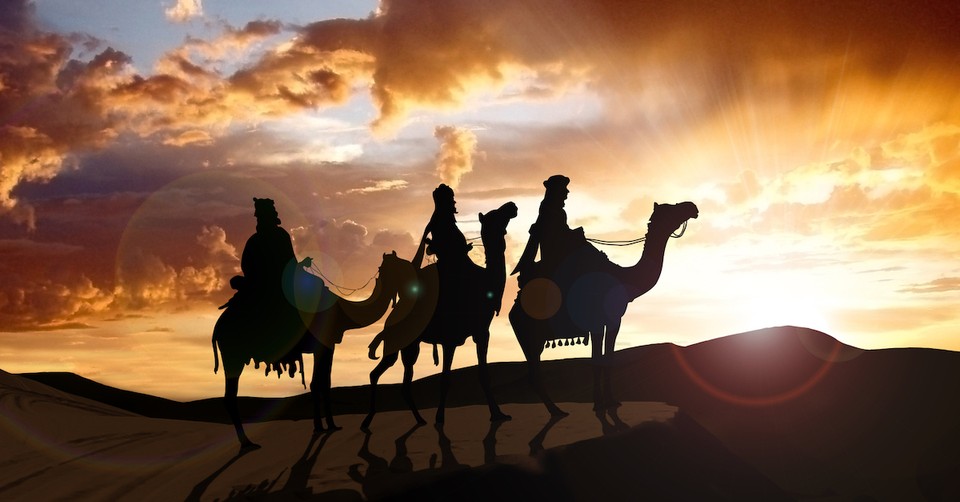What Do We Really Know about the Wise Men Who Visited Jesus?

“Where is he who has been born king of the Jews? For we saw his star when it rose and have come to worship him.” Matthew 2:2 NIV
The wise men, or magi, are a hallmark of the scene of Christ’s birth. Trusting in their scholarly instincts to follow a star in search of a new king, God illustrates His Lordship and Fatherhood over all, and how He seeks to call all of us home to Him. Though not biblical scholars, they found and worshiped Jesus as King, yet many who knew the law and prophesies missed Christ altogether. “Here the first worshipers are court magicians or astrologers or wise men not from Israel but from the East- perhaps from Babylon,” notes John Piper, “They were gentiles. Unclean. And at the end of Matthew, the last words of Jesus are, ‘All authority has been given to Me in heaven and on earth. Go therefore and make disciples of all the nations.’"
What Does the Bible Tell Us about the Wisemen?
When they saw the star, they rejoiced exceedingly with great joy. And going into the house, they saw the child with Mary his mother, and they fell down and worshiped him. Then, opening their treasures, they offered him gifts, gold and frankincense and myrrh.” Matthew 2:10-11
The wise men fulfilled the prophecy of Isiah 60:1-6. Matthew doesn’t call them wise men or kings but magi. It was customary for dignitaries to welcome and congratulate new rulers. The Bible tells us the magi were Gentiles, their very way of life a direct violation of the Old Testament. “Astrology, as a form of divination, was forbidden in Scripture,” states the NIV Cultural Backgrounds Study Bible, “Yet these Magi came to worship the new king; as Matthew often emphasizes, God calls followers from unexpected places.”
The wise men most likely traveled with an extensive caravan and are storied to have followed a star to the Christ child. Matthew does not state the movement of the star, which came to be known as the Star of Bethlehem, specifically. “He says they saw a star,” wrote Dwight Longenecker for crosswalk.com, “which history teaches is the North Star.” The wise men were from the east, maybe even Babylon. “‘Orient’ is a largely outdated word for eastern Asia,” wrote Greg Lanier for TGC, “Babylonia is a great candidate [for the Magis’ origin], since they would have come into contact with Israel’s Scriptures during the captivity.” The gifts they presented to Jesus were expensive and imported from Arabia and Somaliland, for royalty and luxury.
What Does History Tell Us about Magi from the Ancient Near East?
Magi were advisers to earthly kings who sought wisdom, counsel, and dream interpretation from those other than God and His prophets. “The Magi were a famous class of astrologers and dream interpreters who served the Persian king.” (NIV Cultural Backgrounds Study Bible) Astrology was considered the science of the ancient world. “Magi is an ancient word referring to pagan astrologers,” wrote David Mathis for desiringGod, “And since they dabble in the dark arts, we eventually go our English word magic from such magi.” They were known for interpreting dreams, and God uses that confidence in their ability to warn them not to return to Herod after visiting Jesus.
God is the Author of life and Creator of all. The very talents He gives to us are specifically purposed, even beyond what we understand and can fathom, as the wise men illustrate. They were most likely Zoroastrian dualists or polytheists and did not worship the One True God as their God. But God used them and their gifts, anyway. “Some unusual movement or stellar event of great magnitude was often though to herald the birth of a King or someone of great personage,” wrote Dr. Roger Barrier.
Tradition tells us the magi traveled in numbers of three, perhaps associating one man to each gift brought to Jesus, but their number could have been twelve or more. “Tradition pegs their number at three,” wrote Greg Lanier for TGC, “But we simply do not know. Matthew just uses the plural.” They most likely traveled on Arabian horses, not camels. “At the time of Christ’s birth camels were used as pack animals,” wrote Dwight Longenecker for crosswalk.com, “but wealthy travelers used the more comfortable and swift horse.”
What Is the Timeline for the Wisemen's Journey to Visit Jesus?
“Now after Jesus was born in Bethlehem of Judea in the day s of Herod the king, behold, wise meant from the east cam to Jerusalem, saying, ‘Where is the he who has been born king of the Jews? For we saw his star when it rose and have come to worship him.’” Matthew 2:1-2
Though they are often placed at the scene of Jesus’ birth, Scripture does not confirm that detail. Historical accuracy points to their arrival weeks, possibly even months, after Christ’s birth. At the sight of the star, they set off on their journey, which required quite a bit of time to cover the distance from somewhere in the far East to Bethlehem. Expecting to find the king of the Jews in the palace in Jerusalem, the Magi arrived in Jerusalem, six miles from Bethlehem (NIV Cultural Backgrounds Study Bible). Matthew doesn’t specify how long their visit with Herod lasted, but it was a three-hour journey from there. “Matthew describes Jesus as a ‘child,’ not a ‘baby’ as in Luke 2:12,” wrote Greg Lanier for TGC, “And the magi visit him in a house, where the family apparently relocated after the birth.”
Today, the arrival of the wise men is celebrated by some as the feast of the Epiphany, six days after Christ’s birth on January 13th. “The Epiphany,” notes Samuel James Andrews for christianity.com, “or manifestation of Christ, and originally had reference to the visit of the Magi and to His baptism; and later, to His first miracle.” Though not chronologically accurate, the feast is still recognized in both Greek and Roman Churches. “The wise men were not at the manger on Christmas night,” wrote Dr. Roger Barrier, “When they arrived in Bethlehem several months to two years later, Joseph, Mary and Jesus were living in a house.”
What Do We Learn from Herod's Interaction with the Magi?
“Being warned in a dream not to return to Herod, they departed to their own country by another way.” Matthew 2:12 (ESV)
Though Herod built the temple, he also contributed to temples for Caesar in Gentile cities. “So protective was Herod of his power and so jealous of potential rivals that his more popular brother-in-law, a very young high priest, had a drowning ‘accident’-in a pool that archaeology shows was very shallow,” states the NIV Cultural Backgrounds Study Bible. He had his favorite wife, three sons, his mother-in-law, and his uncle executed!
When the magi inquired about the new king they had traveled to worship, “Herod summoned the wise men secretly and ascertained from them what time the star had appeared. And he sent them to Bethlehem, saying, ‘Go and search diligently for the child, and when you have found him, bring me word, that I too may come and worship him.’” (Matthew 2:7-9) Thankfully, the wise men were warned in a dream not to return, but as a result, Herod had all male children two years and under killed.
Our Heavenly Father’s perfect plan is carried out flawlessly, despite the sin and rebellion of humanity. Jesus escaped Herod’s massacre. The part each person played in Christ’s birth story wasn’t necessary for Him to survive but allowed them to be a part of God’s plan. He continually draws us closer to Himself by allowing us the privilege of serving Him and glorifying His name here on earth. Even those such as the wise men, following the laws of science of their day, are created to be drawn to God. In His perfect way, He calls every heart home.
Is the "We Three Kings" Song Accurate?
“And nations shall come to your light, and kings to the brightness of your rising.” Isaiah 60:3 (ESV)
There may not have been three of them, and the magi were not kings, “They are pagan astrologers,” notes David Mathis for desiringGod.com, “not too far from what we’d call sorcerers and wizards.” Matthew’s Gospel does not mention the following of a star “Westward leading,” though stars were associated with ancient political events. From ancient prophecy, they knew the star meant the true king of Israel promised by God was born. The wise men did come from the East, but probably not from the “orient.” They most likely came from Persia, Arabia, or Babylon.
“They shall bring gold and frankincense, and shall bring good news, the praises of the Lord.” Isaiah 60:6
They did indeed bring gifts of gold, frankincense, and myrrh. The lyrics of the famous Christmas carol do not set the scene on the night of Christ’s birth, as we associate them, but accurately describes their journey to find the Christ child and worship Him as King of all Kings. They found Jesus in Bethlehem, as the song sings, and worship him as “King for ever, ceasing never…Over us all to reign.”
The carol sings of the significance of their gold and frankincense. Gold, in recognition of His kingship, frankincense to signify His deity. Myrrh, though not described in the song, symbolizes Christ’s death. It was used in ancient burials. Since the number of wise men is unknown, so too are the number of each gift given to Jesus.
Why Are the Wisemen Included in the Nativity Scene?
Like the shepherds in the field, the wise men weren’t present for the birth of Christ, either. All are represented in the same scene to capture the full weight of Jesus’ birth on earth. Encyclopedia Britannica notes, “The shepherds symbolize the revelation of Christ to the Jews, and the wise men symbolize the revelation of Christ to the Gentiles.” The magi are not typically placed in the manger. Rather, they are set off to the side, sometimes on or with the animals they used to travel there. Some traditions leave them out of the scene entirely until after Christ’s birth, signifying their visit after the child was born.
Smith’s Bible Dictionary notes, “According to late tradition, the Magi are represented as three kings, named Gaspar, Melchior, and Belthazar, who take their place among the objects of Christian reverence.” Storied tales have come to include distinct characteristics and countries of rule, though not historical fact. Gaspar, King of Sheba who bears the gift of Frankincense, wears a green cloak and gold crown with green jewels on it. Melchior, King of Arabia who presents gold, has long white hair and beard and dons a gold cloak. Balthazar, King of Tarse and Egypt gives the gift of Myrrh, wearing a purple cloak and black beard.
The storied and prophetic notes of every character we place in the nativity scene dance together to form the greatest love song of all time. God, out of His love for us, sent Jesus to earth to live among us, teach us, and die for us sacrificially to save us from the penalty of sin . . . which is death. The story of the wise men pulls specifically at our hearts because He came not just for God’s chosen people, but for all of us. Even those who turn their backs and do not believe in Him, He chose to die for. In some ways, the nativity scene represents the mystery surrounding every life’s purpose. The details of which, God only knows, but the motivation remains the same through all time: Love.
We are loved, for who we are, right where we’re at. Just as God drew the wise men to Jesus, so He draws us through our everyday lives, begging us to keep taking faithful steps towards the light, in search of the King of Kings.
Photo credit: ©GettyImages/Pink_frog

Originally published December 13, 2019.




